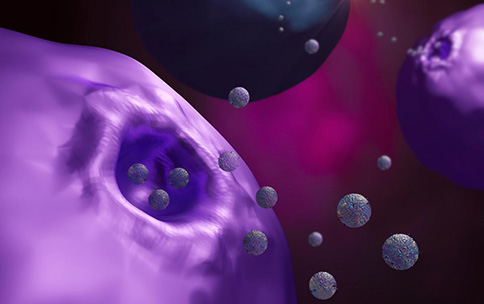
The Common Fund Extracellular RNA Communication (ERC) program is focusing on development of tools and technologies to address major barriers to fully understanding and harnessing the therapeutic potential of extracellular RNA molecules (exRNAs), a type of RNA molecule that exists outside of the cell that produced it. This includes focusing on a greater understanding of the structures like Extracellular Vesicles (EVs) that carry exRNAs through the human body. Currently, a lack of uniform methods to purify and characterize EVs and the molecules they carry, like RNA, remain challenging. EVs are very small and come in many varieties and therefore they can be difficult to collect and study. Furthermore, even if they use the same equipment, many labs study EVs using different methods, making it difficult to compare and reliably reproduce results. Researchers from the NIH Common Fund ExRNA program, working with partners in the scientific societies including the International Society for Extracellular Vesicles (ISEV (link is external)), the International Society for Advancement of Cytometry (ISAC (link is external)) and the International Society on Thrombosis and Haemostasis (ISTH (link is external)), have developed a consensus framework that outlines the minimum information that should be included in publications so that certain experimental results from EVs can be consistently compared and reproduced. This consensus framework called: MIFlowCyt-EV (Minimum Information about a Flow Cytometry Experiment-Extracellular Vesicles) was developed for a specific type of experiment called flow cytometry that has been adapted to study EVs. Flow cytometry was originally designed to study individual cells, and its application to the analysis of EVs and other tiny particles has presented many challenges, and sometimes controversial results. This is in part due to limitations of the instruments used, lack of robust methods, and ambiguities in how data should be interpreted. It is also due to the fact that most flow cytometry equipment was made to sort cells, not the much smaller EVs produced by cells. The MIFlowCyt-EV framework incorporates an understanding of these limitations in the reporting requirements in an effort to fully capture meaningful data. As more and more researchers adhere to these standards in reporting EV flow cytometry studies, the ability to accurately compare results from different research labs will increase and measurement and analysis of EVs will improve.
Welsh JA, Van Der Pol E, Arkesteijn GJA, Bremer M, Brisson A, Coumans F, Dignat-George F, Duggan E, Ghiran I, Giebel B, Görgens A, Hendrix A, Lacroix R, Lannigan J, Libregts SFWM, Lozano-Andrés E, Morales-Kastresana A, Robert S, De Rond L, Tertel T, Tigges J, De Wever O, Yan X, Nieuwland R, Wauben MHM, Nolan JP, Jones JC. MIFlowCyt-EV: a framework for standardized reporting of extracellular vesicle flow cytometry experiments. J Extracellular Vesicles. 2020 Feb 3;9(1):1713526. doi: 10.1080/20013078.2020.1713526.


